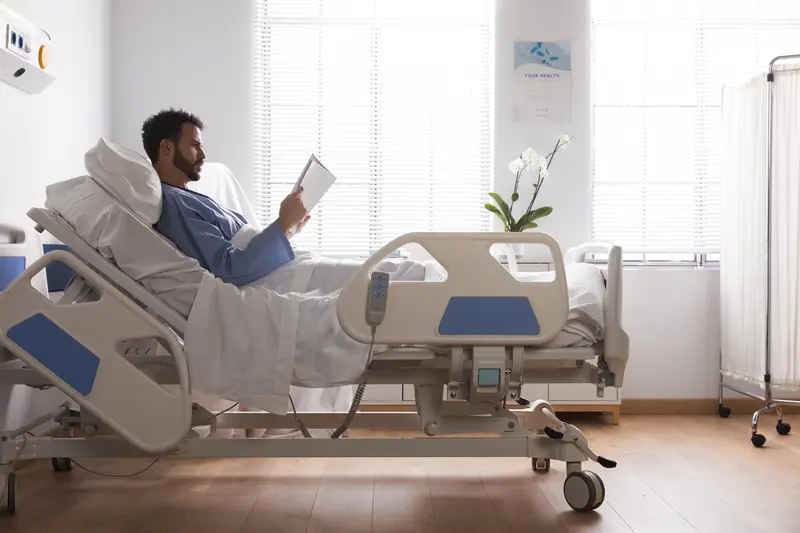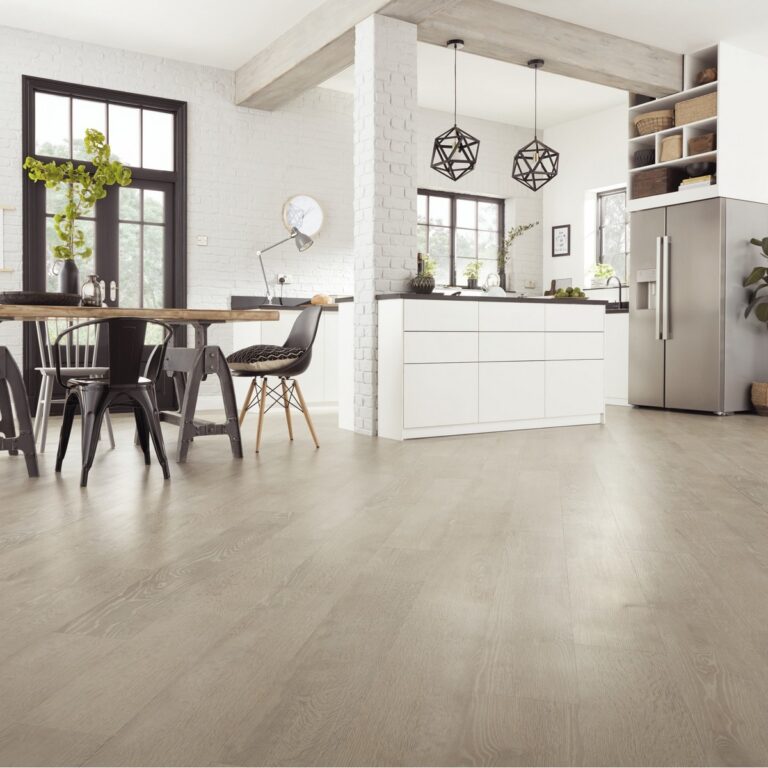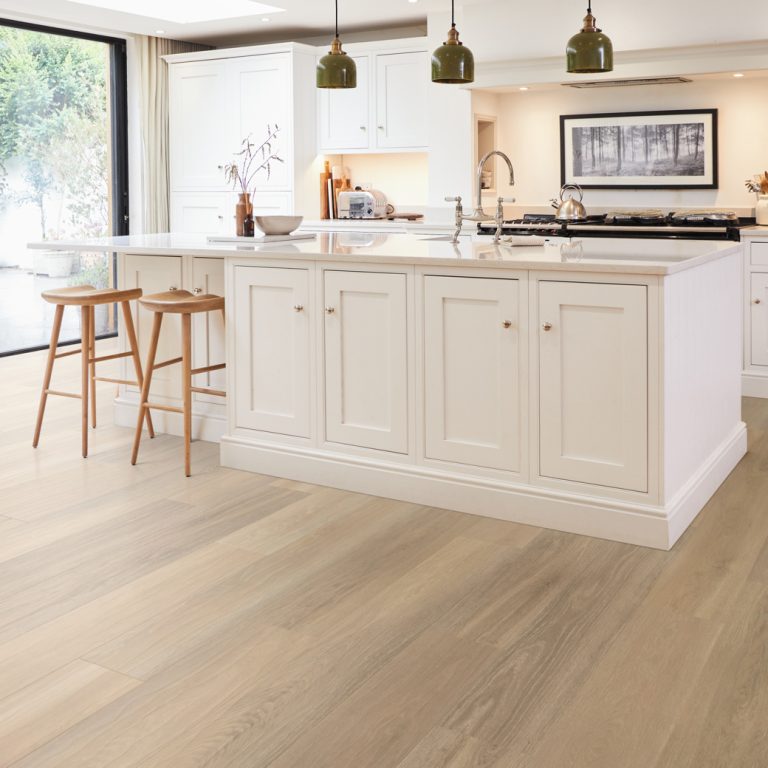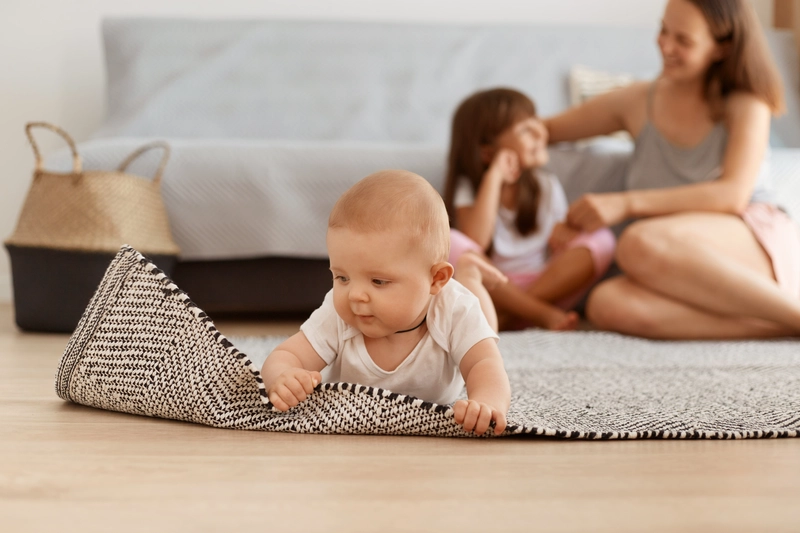Vinyl flooring is emerging as a preferred option in hospital settings and for significant reasons. Its distinctive blend of durability, ease of maintenance, and aesthetic versatility renders it particularly suitable for high-traffic medical environments. This article examines the characteristics of vinyl flooring for hospitals, elucidates its specific advantages, and outlines the various types available.
It also addresses critical considerations when selecting the appropriate flooring, such as choosing flooring that adheres to Healthcare standards, and offers guidance on installation and maintenance, thereby ensuring a safe and visually appealing environment for both patients and staff, visitors, and healthcare settings.
What Is Vinyl Flooring?
Vinyl flooring is a versatile and widely used flooring option in various settings, including hospitals, due to its excellent combination of durability, aesthetic appeal, and functionality. Specifically designed to withstand the challenges posed by high-traffic areas, vinyl flooring incorporates innovative technology to provide features such as moisture resistance and noise reduction, making it a preferred choice for healthcare settings.
Options like luxury vinyl tiles and eco-friendly solutions enable facilities to meet both style and sustainability standards, while materials have additional design possibilities, including sustainable options like Bamboo flooring.
Why Is Vinyl Flooring Suitable for Hospitals?
Vinyl flooring, including rubber flooring, is an exceptional choice for hospitals due to its outstanding features that prioritise patient comfort, safety, and hygiene, which are paramount in healthcare settings.
1. Easy to Clean and Maintain
One of the key benefits of vinyl flooring is its ease of cleaning and maintenance, which is critical in hospital environments where hygiene is of utmost importance. Regular maintenance of hospital flooring made of vinyl ensures that surfaces remain free from contaminants and stains, allowing for effective infection control and compliance with health regulations.
To maintain the pristine condition of vinyl flooring, hospitals often utilise a multi-step cleaning process that begins with sweeping or vacuuming to remove loose dirt and debris, especially in health clinics. This is followed by mopping with warm water mixed with a gentle neutral pH cleaner, specifically formulated to avoid damaging the flooring while effectively eliminating grime.
For more stubborn stains, a diluted solution of isopropyl alcohol can be applied, ensuring surfaces remain both clean and safe.
Regular inspections help identify wear and tear. Using matting can further protect floors and reduce cleaning frequency.
Investing time in these cleaning rituals not only enhances the aesthetic appeal of the facility but also fosters a safer environment, aligning with stringent safety flooring standards. By prioritising cleanliness, health clinics can significantly improve operational efficiency and patient safety.
2. Resistant to Stains and Spills
Vinyl flooring is designed to be highly resistant to stains and spills, making it an ideal choice for hospitals where accidental messes are common. This stain resistance not only preserves the aesthetic appeal of the flooring but also contributes to its durability and ease of maintenance in demanding healthcare environments.
This advanced material is typically composed of multiple layers, including a sturdy backing and high-performance wear layer that work together to provide remarkable protection against various contaminants. In addition, surface treatments further enhance its resilience, ensuring that it can withstand the harsh chemicals often used in a medical setting.
For example, common spills in hospitals may include blood, disinfectants, and food items, all of which pose significant challenges to flooring materials. Thanks to its robust composition, vinyl flooring can effectively repel these substances, preventing them from penetrating its surface.
Long-term maintenance benefits include reduced cleaning times and lower associated costs, ensuring a cleaner and safer environment.
The ease of stain removal makes it less likely for unsightly marks to linger, which is essential in upholding the hygiene standards required in healthcare facilities.
3. Durable and Long-lasting
Durability is a hallmark of vinyl flooring, including options like vinyl composite tile (VCT), making it an excellent long-term investment for hospitals where heavy foot traffic and equipment movement are routine. High-quality commercial flooring options, such as those made from luxury vinyl tiles, ensure that the flooring remains intact and visually appealing even under the most demanding conditions.
This exceptional flooring choice features a range of durability aspects that contribute to its overall resilience in a hospital environment. Thickness plays a crucial role, as many vinyl flooring products range from 4mm to 6mm, providing enhanced stability and support.
A robust wear layer of 20 mils or more acts as a shield against scratches and dents, crucial in high-traffic areas. Resistance to impact is another distinct advantage, with vinyl capable of absorbing shock from wheeled equipment, significantly reducing the risk of damage compared to other materials.
In comparison, other flooring options, such as carpets or natural wood, may require frequent replacements and maintenance. Data shows that vinyl flooring can last 15 to 20 years under normal hospital usage, whereas these alternatives may only last 5 to 10 years. This longevity makes vinyl an economical choice for healthcare facilities dedicated to maintaining both aesthetics and practicality.
4. Slip-resistant
The anti-slip properties of vinyl flooring play a crucial role in enhancing safety within hospitals, significantly reducing the likelihood of slip and fall accidents. This is particularly important for patients, visitors, and staff who may be navigating wet or cluttered environments, ensuring safety and peace of mind.
By incorporating slip-resistant features, vinyl flooring provides a reliable solution tailored to the unique challenges faced in medical facilities. Textured surfaces are among the standout aspects, designed to offer improved grip underfoot. These surfaces not only reduce slip potential but also promote a more confident environment as individuals move across various spaces.
Different flooring options are rated according to their slip resistance, allowing facilities to choose materials that align with specific safety standards and regulations.
- Enhanced drainage capabilities
- Compliance with industry safety ratings
- Maintenance of a clean, dry surface
With these features, adherence to safety regulations is not just a guideline but a fundamental assurance for every hospital environment.
5. Low Maintenance Costs
Low maintenance costs associated with vinyl flooring make it an economically sound choice for hospitals, allowing healthcare facilities to allocate resources more efficiently. The combination of durability and ease of upkeep minimises the need for frequent replacements or extensive maintenance protocols.
Along with its cost-effectiveness, vinyl flooring offers a variety of design options that can cater to the aesthetic requirements of modern healthcare environments. Hospitals often face unique challenges, such as high foot traffic and exposure to spills and stains. Compared to alternatives like carpet or wood, vinyl surfaces are more resistant, ensuring longevity without a significant increase in maintenance demands.
When calculating the overall cost, it is essential to consider not just the initial installation expenses but also the long-term savings achieved through reduced upkeep.
Implementing structured maintenance plans can further lower costs significantly for example, simple regular cleaning and periodic inspections can prevent costly repairs.
By strategically managing flooring maintenance and taking advantage of vinyl’s inherent properties, healthcare facilities can create a more sustainable and economical environment for both patients and staff.
6. Variety of Designs and Colours
Vinyl flooring offers a wide variety of designs and colours, allowing hospitals to create visually appealing environments that enhance patient comfort. This aesthetic flexibility enables healthcare settings to reflect their unique branding while adhering to the functional requirements of hospital flooring.
The options available in vinyl flooring are extensive, featuring patterns that range from classic wood looks to vibrant geometric designs. Utilising textures that mimic natural materials can foster a sense of warm familiarity while calming colours are especially vital in healthcare environments.
Research indicates that the right flooring choices can significantly influence patient perceptions thus, selecting vinyl flooring that promotes a peaceful atmosphere is essential.
- Patterns: Various styles, from elaborate to minimalist.
- Textures: Engineered to provide comfort underfoot, enhancing relaxation.
- Colours: Soft pastels or earthy tones can reduce anxiety.
Ultimately, these design elements not only contribute to aesthetic appeal but also promote healing and well-being for patients and their families. Discover a variety of attractive luxury vinyl flooring designs here.
The Different Types of Vinyl Flooring for Hospitals
There are several types of vinyl flooring for hospitals, each offering unique features and advantages that cater to different needs and preferences.
Options such as sheet vinyl flooring, vinyl tiles, and luxury vinyl tiles (LVT) flooring provide flexibility in design while ensuring the durability and functionality required in commercial flooring applications.
1. Sheet Vinyl Flooring
Sheet vinyl flooring is a popular choice for hospitals due to its seamless installation and exceptional durability, making it ideal for high-traffic areas. This type of vinyl flooring minimises the presence of seams, which can harbour dirt and bacteria, thus enhancing hygiene in critical healthcare environments.
The installation process typically involves thoroughly cleaning the subfloor to ensure that it is smooth and free of debris. Once prepared, the flooring sheets are carefully measured and cut to fit the designated areas, followed by the application of a strong adhesive to secure them in place.
Following installation, the maintenance requirements are relatively low. Regular cleaning with appropriate solutions ensures that the surface remains free of contaminants, thereby supporting infection control efforts.
- Daily sweeping and mopping are recommended.
- Occasional deep cleaning can prolong its lifespan.
- Promptly address any tears or damage to maintain integrity.
Specific applications of sheet vinyl flooring in hospitals include operating theatres, patient rooms, and waiting areas, where cleanliness is paramount. The advantages it holds over other flooring types, particularly in the context of infection control, include its ability to resist moisture and withstand heavy foot traffic, ensuring that hospitals can provide a safe and hygienic environment for patients and staff alike.
2. Vinyl Tiles
Vinyl tiles offer a versatile flooring solution for hospitals, allowing for creative design options while maintaining the durability essential for healthcare settings. Their tiles can be replaced easily, offering a practical solution for maintenance without the need for extensive floor replacements.
This adaptability comes not only from their resilience but also from the vast array of colours and patterns available. Hospitals can choose from a spectrum that ranges from calming blues and greens to vibrant reds and yellows, creating an atmosphere conducive to healing.
Patterns can mimic natural materials like wood or stone, enhancing the aesthetic appeal.
Custom designs can also promote wayfinding, aiding patients and visitors in navigating the facility with ease.
Along with the stylish appearance, the ease of repair and minimal maintenance requirements contribute significantly to the overall functionality of these floors. Epoxy flooring offers another durable and easy-to-maintain option, highly suitable for high-traffic areas in hospitals.
As a result, hospitals can maintain a clean and welcoming environment while ensuring that their flooring remains intact and attractive for many years. The use of Terrazzo flooring is also gaining popularity due to its durability and aesthetic appeal.
3. Luxury Vinyl Tiles (LVT)
Luxury vinyl tiles (LVT) combine both aesthetic appeal and unparalleled durability, making them an excellent flooring choice for hospitals seeking both style and functionality. With advanced printing technologies, LVT can mimic the look of natural materials like wood or stone, providing a high-end appearance while retaining essential characteristics such as moisture resistance and easy maintenance.
This innovative flooring option not only elevates the overall atmosphere of healthcare environments but also addresses practical needs. For instance, its versatile design aligns seamlessly with various themes—whether aiming for a tranquil, calming ambience in waiting areas or a vibrant, stimulating environment in paediatric departments.
LVT’s user-friendly nature ensures minimal disruption during installation and allows for quick replacements when necessary, providing functionalities that resonate strongly within the healthcare realm.
- Visual appeal that enhances patient experience
- Durability suited for high-traffic areas
- Moisture resistance for hygiene maintenance
Ultimately, LVT proves to be a game-changer, marrying style with practicality in spaces where comfort and function are paramount. Options provide additional elegant solutions that enhance the aesthetic without compromising on durability.

See product: Karndean Van Gogh Rigid Core Frosted Stone
Factors to Consider When Choosing Vinyl Flooring for Hospitals
When choosing vinyl flooring for hospitals, several critical factors must be considered to ensure that the selected flooring meets both functional and aesthetic needs. Those factors include:
1. Durability and Maintenance, Including VCT and Other Options
Durability and maintenance are fundamental considerations when selecting flooring for hospitals, as these factors directly impact the longevity and hygiene of the environment. High-quality hospital flooring must withstand frequent cleaning, heavy foot traffic, and potential spills, ensuring that it remains in optimal condition over time.
There is a wide array of flooring materials available, each presenting unique advantages and challenges. For instance, vinyl flooring is well-known for its resilience and ease of maintenance, making it a popular choice in medical facilities.
Similarly, linoleum flooring offers an eco-friendly choice, while
- Carpet tiles offer comfort but may require more intensive cleaning protocols.
- Epoxy floors provide a seamless, durable option that stands up to chemicals and moisture.
- Bamboo flooring provides natural aesthetics and sustainability.
When making a flooring decision, it’s crucial to evaluate not just the initial cost but also the long-term maintenance requirements. Regular upkeep not only enhances the aesthetic appeal of the hospital but also ensures safety by minimising slip hazards and maintaining a sterile environment.
2. Slip-resistance and Safety
Slip resistance and safety are crucial elements to consider when selecting flooring for hospitals, as they play a vital role in preventing accidents and ensuring a secure environment for patients and staff.
The choice of flooring can significantly impact the overall safety protocols within a medical facility. Flooring options equipped with anti-slip properties are essential in high-traffic areas where spills may occur. Understanding slip-resistance ratings is vital, as they are measured under various conditions to determine a material’s effectiveness in preventing slips. Regulations established by organisations dictate the minimum acceptable slip-resistance levels, ensuring that all hospital environments remain compliant and safe.
Common testing methods include:
- The Pendulum Test
- The Ramp Test
When selecting appropriate materials, it is essential to consider both the intended use of the space and the likelihood of wet conditions, paired with relevant certifications, industry standards, and resistance that guarantee the flooring will perform effectively in real-life scenarios.
3. Design and Aesthetics
Design and aesthetics play a significant role in creating a welcoming and healing environment within hospitals, influencing patient perceptions and overall comfort. The choice of vinyl flooring can enhance the visual appeal of healthcare settings, contributing to a calming atmosphere for patients and visitors alike.
An inviting atmosphere not only assists in the healing process but also helps alleviate anxiety, which is often experienced by patients and their families. Integrating different elements of design—such as colour and pattern—is crucial.
Hospitals are increasingly employing warm tones, soothing textures, and nature-inspired designs to facilitate relaxation and a sense of safety. Vinyl flooring offers versatility, allowing for unique patterns that can enhance any design theme while ensuring practical functionality.
- Neutral palettes can instil a sense of serenity.
- Bright accents can uplift the surroundings.
- Natural patterns can invoke the tranquillity of the outdoors.
These choices, when carefully considered, can significantly impact patient recovery and staff efficiency, thereby promoting a holistic approach to healthcare.
4. Cost and Budget, Including Considerations for Green Guide for Healthcare and LEED
Cost and budget considerations are vital when choosing flooring for hospitals, as they directly influence project planning and resource allocation. Selecting vinyl flooring can provide a cost-effective solution that balances up-front investment with long-term savings in maintenance and durability.
In the realm of healthcare facilities, the initial choice of flooring materials can greatly determine operational efficiency and overall patient care. Many decision-makers are discovering that vinyl flooring not only boasts lower installation costs but also offers exceptional longevity compared to more traditional options.
For example, budget-friendly choices like luxury vinyl planks can mimic the appearance of hardwood or tiles while remaining much less expensive.
The durability of vinyl reduces the frequency of replacement, leading to significant savings over time.
To further ease the financial strain, consider financing strategies such as phased installations or seeking grants specifically designated for refurbishing healthcare facilities. These options can facilitate smoother transitions and keep projects within budget.
5. Installation Process
The installation process of vinyl flooring is an essential consideration for hospitals, as it impacts downtime and overall workflow during renovations or new builds.
Understanding the various methods of installation can aid in selecting the most suitable option for specific healthcare environments.
Hospitals often face unique challenges when it comes to vinyl flooring installation, and choosing between professional and DIY methods is pivotal to maintaining operational efficiency. For a professional installation, it is advisable to hire qualified contractors who can typically complete the job within 1-3 days, depending on the size of the area. Ensuring minimal disruption is crucial scheduling work during off-peak hours or utilising temporary barriers can help mitigate the impact on patient care.
On the other hand, for those considering a DIY approach, thorough preparation and planning can lead to successful outcomes, although timelines may extend to a week or more based on skill level. Here are some tips to reduce disruption:
- Establish clear communication with staff about the installation schedule.
- Use signage to redirect foot traffic away from work areas.
- Plan for adequate ventilation and minimise noise during hours of operation
Installation Process of Vinyl Flooring in Hospitals
Installing vinyl flooring in hospitals requires careful planning and execution to ensure that the process is efficient and minimises disruption to daily operations.
Understanding the different installation methods available, including glue-down, loose-lay, and click-lock systems, can aid facilities in making informed choices that enhance functionality and aesthetics.
The Maintenance Tips for Vinyl Flooring in Hospitals
Proper maintenance is essential for ensuring the longevity and performance of vinyl flooring in hospitals, as it directly impacts cleanliness and infection control.
By following best practices for cleaning and maintenance, healthcare facilities can sustain the flooring’s appearance, functionality, and hygiene standards over time.
In conclusion, vinyl flooring has proven to be an ideal choice for hospitals due to its durability, easy maintenance, and ability to withstand high traffic and rigorous cleaning protocols. Hospitals face unique demands that require flooring solutions that not only provide comfort but also support infection control and promote a calming environment for both patients and staff.
For hospitals looking to invest in flooring that combines aesthetic appeal with high performance, TEKA Flooring offers premium brands of luxury vinyl, from Karndean to Luvanto. With a variety of designs crafted to withstand the demands of healthcare environments, TEKA Flooring ensures quality and durability in every product.
Plus, with TEKA Flooring’s expert fitting services, you can count on a seamless installation experience, resulting in a floor that will continue to perform for years to come. Visit TEKA Flooring today to explore our range of luxury vinyl flooring options tailored for hospitals and other healthcare facilities!
Read also:

































